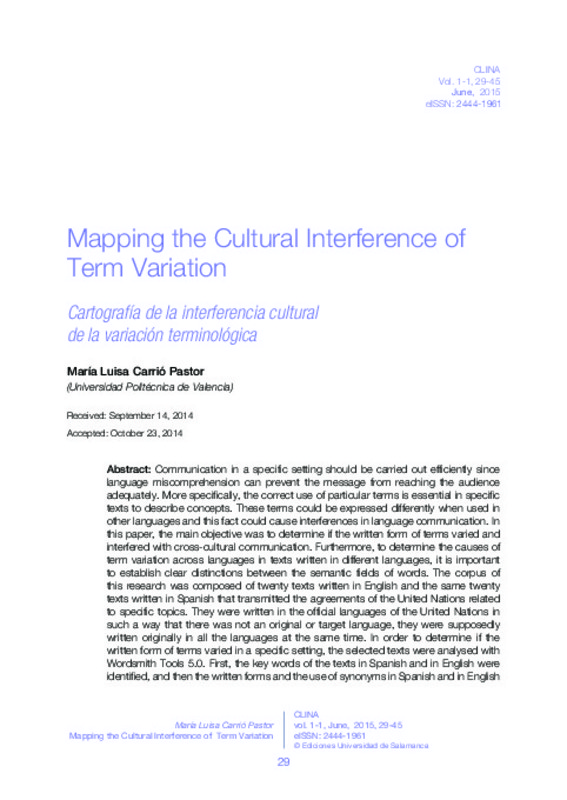JavaScript is disabled for your browser. Some features of this site may not work without it.
Buscar en RiuNet
Listar
Mi cuenta
Estadísticas
Ayuda RiuNet
Admin. UPV
Mapping the cultural interference of term variation
Mostrar el registro sencillo del ítem
Ficheros en el ítem
| dc.contributor.author | Carrió Pastor, Mª Luisa
|
es_ES |
| dc.date.accessioned | 2017-02-20T18:28:30Z | |
| dc.date.available | 2017-02-20T18:28:30Z | |
| dc.date.issued | 2015-06 | |
| dc.identifier.issn | 2444-1961 | |
| dc.identifier.uri | http://hdl.handle.net/10251/78079 | |
| dc.description | CLINA is a Translation Studies journal that addresses the growing need for dissemination platforms to showcase recent advances in Translation, Interpreting and neighboring disciplines. | es_ES |
| dc.description.abstract | [EN Communication in a specific setting should be carried out efficiently since language miscomprehension can prevent the message from reaching the audience adequately. More specifically, the correct use of particular terms is essential in specific texts to describe concepts. These terms could be expressed differently when used in other languages and this fact could cause interferences in language communication. In this paper, the main objective was to determine if the written form of terms varied and interfered with cross-cultural communication. Furthermore, to determine the causes of term variation across languages in texts written in different languages, it is important to establish clear distinctions between the semantic fields of words. The corpus of this research was composed of twenty texts written in English and the same twenty texts written in Spanish that transmitted the agreements of the United Nations related to specific topics. They were written in the official languages of the United Nations in such a way that there was not an original or target language, they were supposedly written originally in all the languages at the same time. In order to determine if the written form of terms varied in a specific setting, the selected texts were analysed with Wordsmith Tools 5.0. First, the key words of the texts in Spanish and in English were identified, and then the written forms and the use of synonyms in Spanish and in English were compared and contrasted. The results showed that there were variations in the interpretation of terms when expressed in different languages and those may be due to cross-cultural interference. | es_ES |
| dc.description.abstract | [ES] La comunicación en un entorno específico debe de realizarse de forma eficiente, puesto que una comprensión incorrecta puede producir que ciertos mensajes no lleguen a la audiencia de forma correcta. De forma más específica, el uso correcto de un término concreto es esencial en textos específicos para describir conceptos. Estos términos se pueden expresar de forma diferente cuando se usan en otras lenguas y este hecho puede causar interferencias en la comunicación lingüística. En este artículo, el objetivo principal es determinar si existe variación en la forma escrita y si este hecho pudiera interferir en la comunicación entre culturas distintas. Así mismo, determinar las causas de la variación de términos cuando se escriben en otras lenguas es importante para poder diferenciar los campos semánticos de las palabras. El corpus de esta investigación está compuesto de veinte textos escritos en inglés y en español cuyo objetivo es transmitir los acuerdos de las Naciones Unidas respecto a cuestiones específicas. Están escritos en las lenguas oficiales de las Naciones Unidas, por lo tanto, en principio no existe una lengua original y una lengua meta. Para determinar si variaba la forma escrita de términos en contextos específicos, se analizaron los textos con Wordsmith Tools 5.0. Primero identifiqué las palabras clave de los textos en inglés y castellano y a continuación comparé su forma escrita y el uso de sinónimos tanto en inglés como en castellano. Los resultados mostraron que existen variaciones en la interpretación de términos cuando se escribían en lenguas diferentes y ello podría ser debido a la interferencia entre distintas culturas. | es_ES |
| dc.language | Inglés | es_ES |
| dc.publisher | Ediciones Universidad de Salamanca | es_ES |
| dc.relation.ispartof | Clina | es_ES |
| dc.rights | Reconocimiento - No comercial - Sin obra derivada (by-nc-nd) | es_ES |
| dc.subject | Specific language | es_ES |
| dc.subject | Terms | es_ES |
| dc.subject | Linguistic Variation | es_ES |
| dc.subject | Written form | es_ES |
| dc.subject.classification | FILOLOGIA INGLESA | es_ES |
| dc.title | Mapping the cultural interference of term variation | es_ES |
| dc.title.alternative | Cartografía de la interferencia cultural de la variación terminológica | es_ES |
| dc.type | Artículo | es_ES |
| dc.rights.accessRights | Abierto | es_ES |
| dc.contributor.affiliation | Universitat Politècnica de València. Escuela Técnica Superior de Ingeniería Geodésica, Cartográfica y Topográfica - Escola Tècnica Superior d'Enginyeria Geodèsica, Cartogràfica i Topogràfica | es_ES |
| dc.description.bibliographicCitation | Carrió Pastor, ML. (2015). Mapping the cultural interference of term variation. Clina. 1(1):29-45. http://hdl.handle.net/10251/78079 | es_ES |
| dc.description.accrualMethod | S | es_ES |
| dc.relation.publisherversion | http://revistas.usal.es/index.php/clina/article/view/12896 | es_ES |
| dc.description.upvformatpinicio | 29 | es_ES |
| dc.description.upvformatpfin | 45 | es_ES |
| dc.type.version | info:eu-repo/semantics/publishedVersion | es_ES |
| dc.description.volume | 1 | es_ES |
| dc.description.issue | 1 | es_ES |
| dc.relation.senia | 306130 | es_ES |






